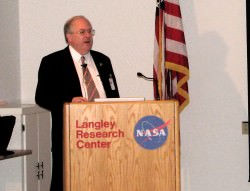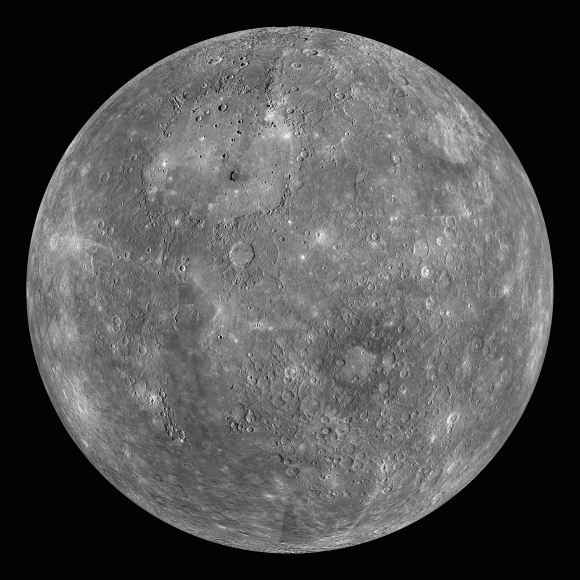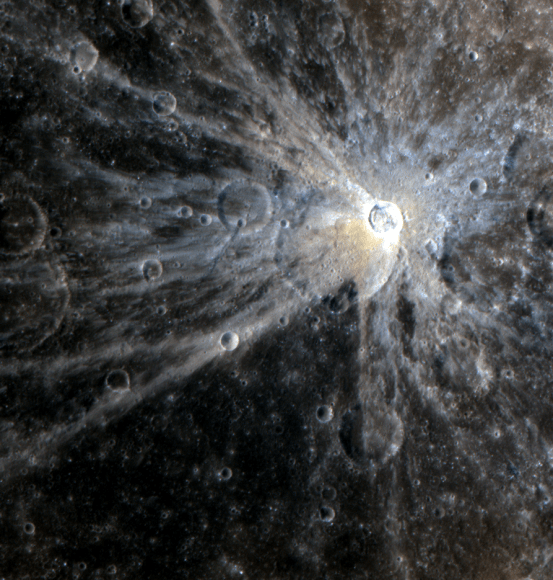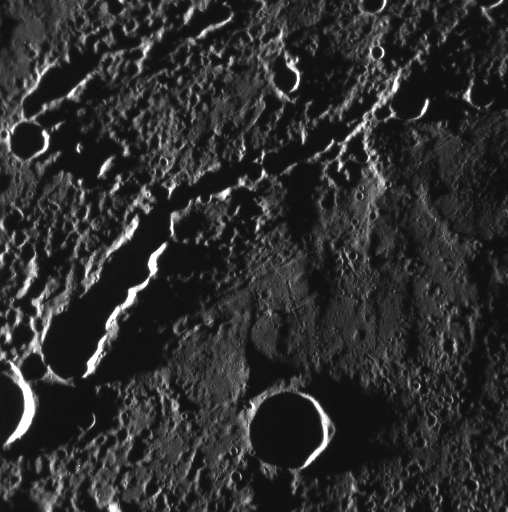[/caption]
Editor’s note: Bruce Dorminey, science journalist and author of “Distant Wanderers: The Search for Planets Beyond the Solar System,” interviews NASA’s MESSENGER mission Project Scientist Ralph McNutt about what we are learning about Mercury.
Thirty-five years after NASA’s Mariner 10 interplanetary probe flew by and imaged less than half of tiny Mercury’s surface, NASA’s MESSENGER spacecraft now orbits our Solar System’s enigmatic and poorly understood innermost planet. After a six-and-a-half-year journey — which included three flybys of Mercury — MESSENGER is now the first spacecraft to take up long-term residence around this hard-to-reach and hellish planet.
Crater-scarred Mercury lies at an average distance of only 58 million kms from the Sun, so searingly close that its angular separation (or elongation) from our own star is never more than 28 degrees. This all makes it extremely difficult to study from Earth.
Thus, planetary scientists are thrilled to finally be analyzing new in situ data from the MESSENGER (MErcury Surface, Space ENvironment, GEochemistry, and Ranging) spacecraft.
To get some perspective on the findings and Mercury itself, we turned to the MESSENGER Project Scientist Ralph McNutt at Johns Hopkins University’s Applied Physics Lab.
Dorminey — Is the MESSENGER data already shaking up Mercury paradigms?
McNutt — Yes – the biggest issue has been the volatile content which is likely going to lead to an interesting, but productive debate, about implications for planetary origins in the inner solar system.
“Volatile” elements are those with relatively low melting and boiling points. “Refractory” elements have relatively high boiling and melting points. If Mercury has a large core due to the surface being “boiled off” by a hot solar wind or hotter Sun in the early days of the solar system, or by a giant impact, then it is more difficult – but perhaps not impossible – for the volatile to refractory ratio, as exemplified by the potassium to thorium ratio (K/Th), to be as high on Mercury as at Earth, Mars, and Venus. And yet that is what the data are saying.
Dorminey — What could explain Mercury’s magnetic field being offset north of the planet’s center by 20 percent of its radius? Was this offset due to a giant impactor?

McNutt — My guess would be that the offset is not due to a giant impactor. But we still do not have a good explanation.
Dorminey — But does the in situ measurement of this magnetic field also confirm that Mercury still has an active magnetic dynamo?
McNutt — There seems to be no way that [Mercury] can escape having a dynamo, so that already makes for implications about Mercury’s cooling history and the chemical mixture [needed] for the dynamo action. There needs to be mostly iron, but something else must be mixed in to help lower the freezing point, otherwise the dynamo should have frozen out some time back.
“Dynamo” in either a planetary or commercial context refers to the generation of electricity by movement of a conductor with respect to a preexisting magnetic filed. Such a movement produces an electrical current, which, in turn, produces a magnetic field.
In a planet, the conductor is a liquid with motion derived from the rotational energy of the planet. But a full theoretical description of how planetary dynamos work is still lacking and is the subject of ongoing research.
Dorminey — A popular formation theory, which would explain its anomalously large iron core, is that early Mercury was stripped of its outer layers following a giant impact. Do you adhere to this idea?
McNutt — Nominally, a high volatile content – expressed via a high potassium to thorium ratio (K/Th), which we have measured with the MESSENGER gamma-ray spectrometer, would rule against such a massive impact. The thinking has been that the volatile content would not re-accrete and so one would be left with a low global average such as is measured for the Moon. We will see – I do not think the verdict is in yet on this one.

Dorminey — What is the significance of and where did it get its surface sulfur and potassium?
McNutt — Sulfur and potassium were both elements in the initial solar nebula. The real question is what led to their placement and relative concentrations on the surface of Mercury.
Dorminey — What’s the significance of the MESSENGER-imaged volcanic vents? Is Mercury still tectonically active?
McNutt — The volcanic vents tells us that volcanism was a significant part of the geologic history of the planet. The planet has cooled a lot since there was a lot of activity and continues to cool. The level of activity is likely low at best – but if we see an active [volcanic] vent, we will definitely let the world know.
Dorminey — We know that Mercury has an exosphere, but could Mercury ever have had anything approaching an Earthlike atmosphere?
McNutt — Any sort of a stable Earth-like atmosphere is not in the cards. Mercury is too small with too small a gravity field to hold on to anything for a long time. If there was sufficiently rapid outgassing , then one could have built up an atmosphere of something that might have Earth-like pressures, but certainly no oxygen, and not for long given the temperature.
Dorminey — What is still the most puzzling to you about Mercury?
McNutt — Right now, the biggest puzzle is how to put together the magnetic field configuration (with the offset), with a dynamo, and the topography and gravity data all in a self-consistent description of the planet. There will be some more papers coming out on these topics in the near future.
Dorminey — If money were no object, what would be the ultimate science exploration strategy for Mercury? Are there any plans in the works for a lander?
McNutt — To really understand the solar system, we need to put together a coherent chronology of formation and early thermal evolution of the planets and other solar system objects. To do that “right” one needs well-characterized samples returned from the surface or drilled from the near-surface, in pristine environments and delivered to labs on Earth. Sample returns are hard – but not as hard as placing such equipment in situ. Following the next level of intense study by BepiColombo (the ESA orbital mission now in development), the next step is a lander. There are no plans for such a mission at present. An interesting question is which is harder: a sample return mission from Mercury or from Venus.
Dorminey — With dayside temperatures of 630 kelvin and nightside temperatures of 95 kelvin, could Mercury have ever been a candidate for liquid water or oceans?
McNutt — No.
Dorminey — Could Mercury have ever had microbial life?
McNutt — Before it was known that Mercury rotated, there was some speculation that there might be a zone of perpetual twilight between the Sun-facing hot side and the Sun-shadowed cold side a “twilight zone” where something [like microbial life] might be possible. In actuality, the region between hot and cold would have been fairly abrupt (depending on the thermal conductivity of the rocks). As Mercury does rotate, no such region exists.

Dorminey — What’s the ultimate significance of planetary science’s study of Mercury? Does it offer a template for what you expect in other solar systems, or does your gut tell you that it’s a total fluke?
McNutt — Knowing more about Mercury, and Venus and Mars tells us about the “terrestrial planets” as a whole and what was common – and special – about ours – and their origins. While the new exoplanet discoveries are extremely interesting, we will not get as close to those planets as we can get to the ones in our own Solar System anytime soon. We have yet to be able to resolve other “Mercurys” in our exoplanet searches, so it is as likely as good a template as any. In learned circles at one time in the not too distant past, the entire solar system was considered to be a total fluke.


Dynamo theory is a false myth. Scientists have first to understand the behaviour of gravitation and the heat in the interior of planets and stars. The Inner core of the Earth is the coldest zone of our planet. The magnetic field of the Earth is originated by a mass of solid oxygen (A paramagnetic substance with a tmperature near the absolute cero). Get a summary of the theory for free in the following e-mail. [email protected]
for free??? what a great offer…
Very informative update, thank you!
– As for a remaining dynamo, as I understand it the presence of sulfur makes it difficult to have a small enough solid core and remaining dynamo already on Earth.
Sulfur is present ‘everywhere’ (Mercury, Earth, Io, meteorites) and predicts how a molten core can be formed already when the planet enters final aggregation. An iron-sulfur mixing also predict the relative absence of sulfur in our crust.
The sulfur content lowers the mix melting many hundreds of deg C towards the eutectic mix. But that also makes a problem when the solid iron core finally starts to freeze out. To prevent a rapid freezing as the eutectic is disturbed chemical convection mechanisms have been proposed. Or at least I think so, I am hazy on the details.
– As for volatiles, I don’t understand the proposed argument here. The Moon has a somewhat unexpected store of volatiles, and reminds much of Earth in that respect what I know of. So seeing Mercury having a similar amount of high volatile content would not be surprising.
– As for potentially habitable zones, haven’t MESSENGER revealed ice among the regolith in deep polar craters, as on the Moon? Assuming their margins have remained stable transition zones for geological times, they would be small but existing potential refuges for life.
Abiogenesis could have happened when the impact cooled down and the first water condensed there. This is a minor but viable abiogenesis pathway entertained by some astrobiologists, at least for Earth.
I have wondered if heavy-weight Mercury, with its over-sized core (once having been normal size?), and undersized crust (once thicker, but stripped away by some titanic event?), may not have originally existed in its present Sun-seared, inner Solar System orbit. Apparently, this position has a role in stabilizing the orbital geometry of the terrestrial planets – as they are configured today.
But could there have been a different stabilizing order of placement, with Mercury rotating in a different location – yet, still allowing Earth to remain settled in its life-zone? Could this dense little world have been originally situated in a different place. Is there an assumption that where this fast-moving planet turns today is where it has always revolved?
IIt is intriguing to me that this blistered world is about the same size as the Gas Giant moons Ganymede, Callisto & Titan. Could it have been located elsewhere as a moon? Or a bigger terrestrial planet of life-capable environment further out – and back in time?
Mercury’s offset magnetic field may be another tantalizing clue that the “planet” of today could be the shattered, furnace-reforged, Sun-imprisoned hulk of a once more inviting world that may have existed further out, but was somehow shattered: A moon of Venus? — when that now hellish world may have had Earth-like promise; or, perhaps, of an outer Gas Giant, an orphan hurled out from a past world’s destruction? Or maybe even a mooned world of larger dimension, reigning free in its own terrestrial orbit?
Though laws confine, who can tell. Well, robots are on the scene investigating.
The jury is still out on the question of migration vs formation in place of planets, what I know.
The recent Kepler conference seemed to prefer having many systems with planets formed in place, since that would explain the absence of a mass gap between terrestrials and neptunes.
However one interesting seminar upped the braking interaction of the disk on planets and eliminated the gap while retaining migration. I don’t know how realistic such a set of simulations is against the physical mechanisms of the disk.
[For references, see the Kepler conference video presentations available on the web.]
I subscribe to a different Planet-“formation” process. And so from that reference-frame model, it makes a world of sense to me, in light of other things, that this Solar System of Worlds was very different in its genesis years: I can see a Venus wrapped in a life-beneficent atmosphere, one swirling with cloud patterns, and near its surface of air transparency, the gentle sounds of ocean surf breaking against wide shores of continental masses (with tide-stirring moon, and/or appropriate axial tilt to power gentle winds?), arrayed about a global ocean – and brim with life promise. And a (larger?) Mars, perhaps of Ice Age climatic-topography, edged with seas, under water-cloud-suitable air canopy, and graced with its own moon; and, like Venus – with real life potential.
Now, one is locked in a furnace and buried; the other, air-stripped, and left lethally-exposed, a dry-frozen desert world.
If Mercury is not a fourth planet that may have lay beyond a (closer orbiting?) Mars, or once a hefty moon of Venus (evidently, it was once larger, so it might have been too big, and heavy, to be a planet-stabilizing moon). Maybe, just maybe the asteroid debris belt holds remnant wreckage of its original orbital position? Some of that debris may actually bear mineral-element imprints of a planet’s outer crust. If not Mercury, maybe a lost planet’s core material, as well.
Regarding the “mass gap”, I have long believed that the odd gap between the two planet categories, is not original to the System, and that it is more like a gaping hole, or debris-strewn zone where something once existed. If it does not bear telltale clues of Mercury’s original location, maybe it holds evidence of where a planet (with moons?) once revolved (nothing new in that idea). If so, and then for some reason, that body disappeared, a migration process might have been set motion, repositioning the outer planets: Mars and outer Gas Giants migrating outwards, perhaps? And if Mercury was that planet, maybe it is “fortuitous” that its weighty, compact remains somehow wound up in its present anchoring(?) orbit.
Was Jupiter (once closer to the Sun?), even if not, might it have been a warmer body (not a nuclear radiant one), so that in consequence(?), its real moons – the Galilean satellites – may have been wonders to behold (maybe all four had atmospheres, if not more). Was Europa (it too, once a bigger version of today’s deep-frozen remains?) once an air-enveloped Ocean-World?
Maybe the ancients were right after all, I have wondered, and there were originally Seven Planets: Three Terrestrials and Four Jovian. I see a pleasing symmetry in such a configuration (and can understand its appeal).
Wild speculation, perhaps.
Well, I guess super-computer simulations (fed real-world inputs), could reveal what’s possible and what’s not, according to the governing laws of orbital dynamics, and related principles.
Maybe I need to do more in-depth reading.
Thanks for reference. (Hope I am not abusing a space limitations here.)
The origen of the magnetic field of the earth and other planets will continue being an indescribable phenomenon if scientists continue on the basis of the dynamo theory.
The behavior of gravity and heat in the interior of planets and stars is different to the known behavior on the surface and infinity.
If we review with an open mind the behavior of gravity in the interior of the stars, we may find that the center is not the zone of greatest gravitational attraction, therefore, the center is not the zone of concentration of heavy materials; on the contrary, the tendency to form an empty space.
It is true that the center of the earth is the center of gravity of the earth itself, with respect to the gravity of other objects in the universe, but not the center of gravity with respect to its own mass.
The heat, inside the stars behaves as light behaves with gravity. Therefore, if the center of the stars is not the zone of greatest attraction of gravity, nor is the zone of greatest concentration of heat.
Earth’s magnetic field is produced by a mass of solid oxygen (inner core) that floats in the center of a mass of liquid oxygen (outer core).
The inner core of the earth has the following parts from the center to outside: an empty space of about 1326 kilometers; a spherical shell of solid orthorhombic oxygen (possible magnetic); a spherical shell of solid rhombohedra oxygen (paramagnetic) and a spherical shell of solid cubic oxygen (paramagnetic). [email protected]
Noticed your post: It was informative, in that it unsettled me from encrusted assumption.
So I navigated my way to one portal, and found this concise explanation of what is currently understood, or believed:
“DYNAMO THEORY: geophysical theory that explains the origin of Earth’s main magnetic field in terms of a self-exciting (or self-sustaining) dynamo. In this dynamo mechanism, fluid motion in Earth’s outer core moves conducting material (liquid iron) across an already existing weak magnetic field and generates an electric current. (Heat from radioactive decay in the core is thought to induce the convective motion.) The electric current, in turn, produces a magnetic field that also interacts with the fluid motion to create a secondary magnetic field. Together, the two fields are stronger than the original and lie essentially along the axis of Earth’s rotation.
The dynamo theory was proposed by the German-born American physicist Walter M. Elsasser and the British geophysicist Edward Bullard during the mid-1900s. Although various other mechanisms for generating the geomagnetic field have been proposed, only the dynamo concept is seriously considered today.” — Encyclopedia Britannica
http://www.britannica.com/EBchecked/topic/175210/dynamo-theory
Accompanying 2 minute video gives a nice visual explanation, for those like me who need them.
I did not realize that “The Dynamo Effect”, or Dynamo Theory = Earth’s Magnetic Field, is just that — a Theory: Magnetic Field generated from a solid Iron-Nickel Inner Core — heavy and dense — which revolves within a molten-metalic iron-nickal outer spherical enclosure, stirred with spiral motions, below Earth’s heat-convective Mantle (video).
Can’t quite compute empty-space interiors, however. Others could detail all the complexity, but what about the theoretical processes that form, create super-dense, compact “dynamos”, like Neutron Stars and Black Holes, (they are called holes, though) of evident weight and mass, somehow generating super powerful magnetic fields, and steep gravity curves? They come into existence from implosive compression — creating compact super-density of weight in space, IF I understand.
But then, maybe I am offset, and missed your point — or too enclosed in a box…
“Geo-magnetism is still a very mysterious process.” (Video)
Spectrum7Prism Thanks for your reply. Dynamo theory was proposed by respected scientists, but it does not explain or is not coherent with scientific discoveries such as earth’s magnetic field polarity reverse, decreasing of magnetic intensity which coincides with the global warming, polar wandering, etc. If scientists considerer that inner core is the coldest zone of the planet, the origen of the Earth’s magnetic field will be solved.
The center of gravity of an object is the center of self gravity already in newtonian gravity. In general relativity it is a must, since gravity depends on the system massenergy.
That the Earth and Moon are not hollow is known from respective seismological observations.
Mr. Torbjörn Larsson thanks for your reply. I would suggest to make an analysis of the following site: http://news.illinois.edu/news/08/0310core.html. Perhaps the called innermost inner core is the same empty space inside the inner core of what I mean.